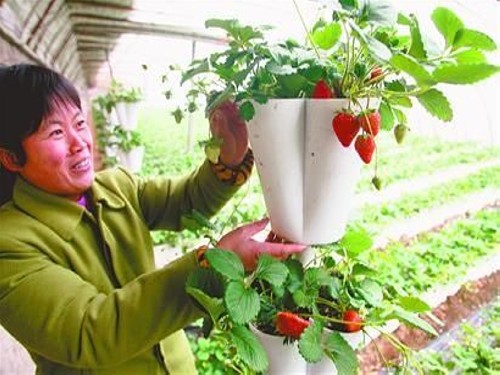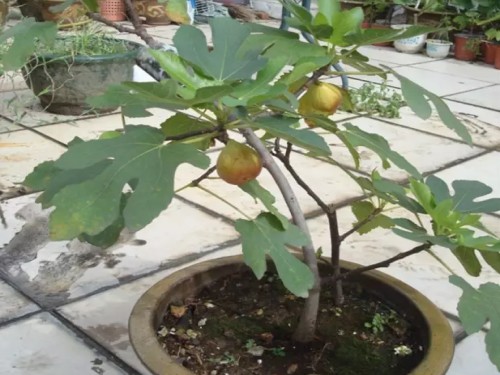What are organic strawberries? Planting techniques of potted organic strawberries
What are organic strawberries? Organic strawberry refers to the fruit and vegetable crops produced through a series of standard operations of organic agriculture, which do not contain any chemical synthetic fertilizers or chemical compound fertilizers, unstable elements (such as radioactive elements, rare earths, etc.), all kinds of unknown or pathogenic microorganisms, heavy metals and other toxic and harmful substances, and other unknown substances, as well as all kinds of hormones, antibiotics, pesticides and fungicides.
Potted organic strawberry belongs to multiple herbs, with short plant type, unique leaf shape, white and fruit red flowers, sweet and fragrant taste, high economic value and ornamental value, can purify the air and beautify the environment, and enrich people's interest. The techniques of potted organic strawberries are as follows:

1. Container selection
A mud basin or porcelain basin or wooden box with a caliber of 21Mel 33 cm can be used. The size is determined according to the number of plants planted, and there are water seepage holes in the bottom of the box. The flowerpot should be soaked in water before planting.
2. Variety selection
General cultivated varieties can be selected, but it is better to be the strawberry variety of the four seasons.
3. Allocation of nutrient soil.
Raspberry like sand, good permeability of the fertile working soil. Therefore, the ideal basin soil is the humus soil on the surface of broad-leaved forest. This kind of soil contains a lot of organic matter, nutrients, loose soil, good water absorption and drainage performance is conducive to the growth of strawberries. Nutritious soil can also be prepared manually, with a ratio of soil, fertilizer and sand at 1:1:1, that is, 1 part of fertile garden soil, 1 part of rotten chicken, duck or sheep manure, and 1 part of river sand; dung, soil and sand are best crushed and screened, and then mixed with 2-3% calcium superphosphate. The prepared nutritious soil can be disinfected with 0.3% potassium permanganate aqueous solution before basin loading. Cake fertilizer can be added appropriately if there are conditions. Put some broken bones, fish meal, hoof shoulders, eggshells and so on at the bottom of the pelvis.
4. Select seedlings
For planting seedlings, we should choose new stolon seedlings of the same year, free from diseases and insect pests, well-developed whisker roots, many white absorbing roots, full terminal buds, medium-sized sturdy seedlings with 5 leaves, short and thick petioles, and a single plant weighing about 25 grams.
5. Planting method
When planting, make the bow back outward so that the root is uniform and the stem is upright. Put some nutritious soil in the basin, spread the roots around, and continue to fill the soil. The planting depth is based on the principle of "no roots at the bottom, no attention at the top". The soil is solid and the seedling position is fixed. Do not fill the basin soil too full, the soil surface and the basin mouth to maintain a distance of about 3, in order to cultivate soil in the future. Before planting, the roots can be soaked in 50 × 10-6 solution of naphthylacetic acid or ABT rooting powder for 1 hour to improve the survival rate. Immediately after planting, pour water thoroughly, wait for the water to seep down, cover the exposed fibrous root with soil, and gently lift the seedling up and compact it again, so that the combination of root and soil is close and the depth is suitable.
6. Daily management
(1) Light
Organic strawberries grown indoors are best placed in a well-lit place to ensure the light needed for growth and for at least 8 hours.
(2) temperature
When growing organic strawberries, it is best to control the temperature at 20-25 degrees Celsius during the day and 10-15 degrees Celsius at night. Do not get too high temperature, otherwise the plant will lead to overnutrition and easy to cause overgrowth.
(3) moisture
In winter, there is usually heating indoors, which is easy to dry. Strawberries and fruits need a lot of water to grow, so to keep the soil moist, it is best to put it indoors with tap water for 2 or 3 days and use your own rice washing water. After fermentation, sesame residue water and milk water are better.
(4) pollination
In production, there should be a seal and wind to help with pollination, and in the shed we can use brush or cotton swabs to help with pollination.
(5) to loosen the soil and seedlings in time.
After the beginning of spring, it is necessary to loosen the soil in time, raise the surface temperature, and the middle ploughing should be shallower, and then the seedlings should be timely.
Time: 2019-05-24 Click:
- Prev

Planting techniques of potted figs
Figs are native to the Euro-Mediterranean coast and Central Asia. They were introduced to China in the Western Han Dynasty and have a long history of growing figs in the Tarim Basin. Figs do not bear fruit without flowers, its flowers are solitary, reddish, hidden in the receptacle, inconspicuous. When the fruit is ripe, the flower falls off, so it is called fig.
- Next

Bonsai cultivation techniques of Sabina vulgaris
Sabina vulgaris is a positive plant, this kind of tree is more shade-tolerant plants, we must choose a relatively dry soil when planting Sabina vulgaris.
Related
- Fuxing push coffee new agricultural production and marketing class: lack of small-scale processing plants
- Jujube rice field leisure farm deep ploughing Yilan for five years to create a space for organic food and play
- Nongyu Farm-A trial of organic papaya for brave women with advanced technology
- Four points for attention in the prevention and control of diseases and insect pests of edible fungi
- How to add nutrient solution to Edible Fungi
- Is there any good way to control edible fungus mites?
- Open Inoculation Technology of Edible Fungi
- Is there any clever way to use fertilizer for edible fungus in winter?
- What agents are used to kill the pathogens of edible fungi in the mushroom shed?
- Rapid drying of Edible Fungi

